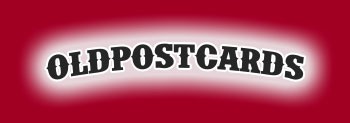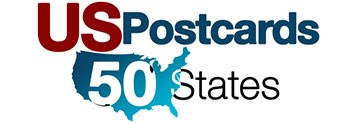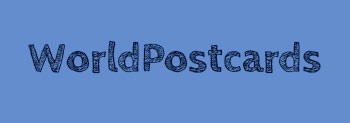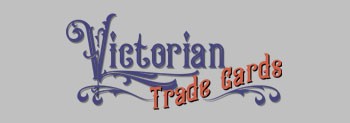Search All Categories
Back 1 Page
Click Banner Below to go to USpostcards.com and Worldpostcards.com
Our Web Sites use different shopping carts and have to be ordered separately
Glossary of Postcard Terms
Glossary from The Encyclopedia of Antique Postcards. Used with permission from Susan Brown Nicholson. Further questions contact Susan Brown Nicholson. Deltiology@AOL.Com
A B C D E F G H I J K L M N O P Q R S T U V W X Y Z
A
- Air Brush
- An airbrush applies a spray of paint, under compression, to a postcard that is usually embossed. The air brush technique allows for blended overlapping of colors and for a rapid application of color replacing time consuming hand painting.
- Album Marks
- discoloration or heavy indentations on the corners of cards from the acid leaching out of antique album pages, or from weight.
- Annual
- A publication that appears every year. At the turn of the century, publishers produced these books for artist, such as Louis Wain and Mable Lucie Attwell, featuring the best of their work. Now, the Annual refers to a guide published each year by The Postcard Collector, listing all postcard clubs, postcard dealers and postcard shops, with articles about postcards.
- Approval Service
- A service whereby dealers send collectors postcards or photocopies of postcards priced for approval. The collector is under no obligation to buy and can return any or all items. Dealers establish who is responsible for the postage. A response should be made within 10 days.
- Arcade Cards
- These items are postcard size, but with plain backs. They usually featured pinup art and were sold in penny arcade vending machines.
- Artist
- In Europe, this refers to cards of actors and actresses. In America, it refers to illustrators.
- Artist Signed
- Any postcard that has a printed signature of the illustrator. This does not mean that the postcard artist autographed the card, although examples of this do exist. If the publisher has printed a byline clearly identifying who did the work, the card is considered artist signed.
B
Top
C
- Checklist
- A list composed by collectors to identify postcards designed by a certain artist or publisher. There are complete checklists of O'Neill, Brundage, Clappsaddle and Paul Finkenrath postcards. It may refer to a list which collectors carry to identify cards needed to complete a certain set or series.
- Chromo Lithography
- Color lithography, see lithography.
- Condition
- Refers to the physical condition of a postcard. Terms used are Mint, Near Mint, Excellent, Very Good, Good, Fair and Poor. Each dealer and auction house uses their criteria for assigning these terms. For example, some would call a card mint if used, but the card is in pristine condition; others would never refer to a used postcard as mint. It is best to understand the grading standards of each establishment.
- Copper Windows
- Flat printed view cards with copper metallic paint applied to the windows of the buildings. The results simulate Hold to Lights.
- Copyright
- the exclusive legal right of an author or artist or his agent to reproduce, publish or sell a literary or artistic work.
D
- Deeks
- Postcard puzzles that change from one view to another simply by tilting the picture. This is sometimes achieved with a small paper tab across the bottom of the postcard.
- Deltiology
- Deltiology is the study of postcards; the person doing the research, a deltiologist. Randall Rhoades of Ashland, Ohio first used the term. It means (from the Greek) the science or study (logos) of small pictures or cards (deltion).
- Die cut
- Any paper object cut by the publisher into a shape other than a rectangle, such as the shape of an angel, Santa or animal.
- Die Cut Hold to Light
- A hold to light postcard that transforms from day to night when a bright light shows through the tiny holes cut on the surface of the card.
- Distributor
- A middleman who obtains postcards wholesale and resells them. He may even pay to be a wholesale distributor that sells them to shop owners. He does not create the design or pay for the printing of the cards.
- Divided Back
- A postcard back with a centerline to divide the address from the message. Divided backs appeared on 1902 in England, 1904 in France, 1905 in Germany, and 1907 in the United States. This helps to date unused postcards. Cards before these dates have undivided backs.
E
- Embossed
- Postcards that have designs slightly raised above the card's surface. Heavily embossed postcards have almost a paper-mache style that stands greatly above the paper's surface.
- Ephemera
- Any printed or hand written item normally discarded after its intended use such as calendars, postcards, trade cards, and valentines.
F
- Foxing
- Brown spots in the paper's surface. These spots of mildew, penetrating the paper, cannot be removed by erasing but may occasionally be removed with bleaching.
G
- Gelatin
- A card with a varnish-like coating producing a glossy surface. The surface usually cracks or shatters. E.A.S. published the only gels guaranteed for life and they have lasted.
- Government Postal
- A postcard that has a preprinted stamp on the back. The government postal office issues these postcards and publishers use them to print designs and advertising messages. They were especially used before the Act of Congress 1898.
H
- Hold to Light
- Any postcard that creates a different image if held to the light. Some are as simple as day into night, others as complicated as winter into summer. There are die cut hold to lights and transparencies.
I
- Installment
- A series of postcards designed to be sent one a day. The completed set forms one picture. Some installments are vertical pictures, such as an Uncle Sam figure; others form horizontal images, such as a running horse.
J
Top
K
Top
L
- Linen
- Postcards published in the late 20s through 50s, using a textured paper with a crosshatched surface. The surface resembles linen fabric. The cards romanticized the images of gas stations, diners, hotels and other commercial buildings. Using the photographic image of an establishment, all undesirable features, such as telephone poles, junk yards, background clutter, and sometimes even cars and people were remove by airbrush.
- Lithography
- A printing process using a smooth, flat, porous surface of stone on which the design is laid down with grease and water so that only certain parts will take the ink and print.
M
- Mechanical
- Postcards that have moving parts. It may be a simple as a die cut top revealing a different idea of the previous image when opened. It could as complicated as pulling a tab for a curtain to move and totally change pictures. Some mechanicals have wheels that change the faces on a body or dates on a calendar.
- Mail Auction
- A process of selling postcards through the mail by dealers or collectors. These may be privately printed auctions or ones that appear in the trade papers, such as Barr's Postcard News or The Postcard Collector. All bidding must be completed by the closing date. Each auction house has rules, which must be understood before bidding.
See approval service.
- Miniature
- A postcard done as a novelty during the Golden Age. They are about one half the size of the standard 3-½ by 5-½ inch postcard. They have stamp boxes and are often postally used. The most desirable are those by the Scandinavian artist or publisher John Winsch.
N
- Net Price Sale
- Sales usually conducted by mail or in the trade publications. Fixed prices are published for each item listed. The postcards are sold on a first come, first served basis.
- Novelty
- These cards include mechanicals, and cards that have items attached, such as bags of salt, real hair, metal medallions, paper applique, silk, or even pennies. Some novelty cards are die cut shapes or have holes in which fingers can be inserted to making the postcard figure appear to have arms, legs, or even a nose.
O
- Oilette
- A term used by Raphael Tuck and Sons of England to refer to a particular style of postcard production. The oilettes often looked like oil paintings, with noticeable brush stokes.
- Over Sized
- The standard postcard size during the golden Age was 3 ½ by 5 ½ inches; the standard modern postcard size is 4 by 6 inches. Any card larger than these sizes are considered oversized. Modern postcards are often called Continentals.
P
- PVC
- Poly vinyl chloride, a polymer derived from vinyl chloride used to make plastic pages and sleeves. These can cause damage to postcards over time.
- Pioneers
- Postcards issued before the Act of Congress. They carry instructions on the back, such as, Write the address only on this side-the message on the other side, or Nothing but address can be placed on this side, or This side for address only.
- Postcard
- A card specifically made with the intention that it could be used by itself as a mailed message or souvenir.
- A company or individual who physically makes postcards. It is usually not the designer of the artwork or the distributor of the postcard, yet it may be the publisher.
- Publisher
- A company or individual who initiated and funded the production of the postcard. They may or may not be the printer of the card. Many postcards identify the publisher. The publisher identification may be accompanied by a copyright date. Other times it clearly states published by…Publishers can be identified by trademark logos, or even the style of the printed word postcard. There may be names of printers or distributors on the backs of cards. These should not be confused with the name of the publisher.
- Puzzle cards
- A European term for installments. In America, it refers to hidden picture cards, jigsaw puzzle postcards, rebus cards, or anything that is a puzzle to solve.
Q
Top
R
- Radiol
- Postcards produced by Paul Finkenrath of Berlin (PFB). The cards have decorative highlights of applied metallic paint, usually copper colored.
- Real Photo
- A term coined to distinguish between commercially printed photographic images and an actual photograph printed on photograph paper with a preprinted postcard back. Real photo cards are more desirable than commercially printed postcards. Most real photos are one of a kind, while commercially printed photographs were produced in large quantity.
- Rebus
- A puzzle postcard on which words, phrases, or sentences are represented by pictures of objects and signs, the names of which, when sounded in sequence, afford the solution.
S
- Sepia
- A dark brown color applied to photographs or other prints. Inky secretions of the cuttlefish produce this coloration.
- Series
- Groups of postcards that belong together in a collection. The individual cards may or may not have been printed at the same time. Examples are Sunbonnets, Bonzo, and Mickey Mouse. More than just a common topic, a series has a common artist and publisher.
- Postcards published in a group of four, six, seven, eight, or twelve. These were sold in packets or individually. Examples are days of the week or months of the year.
- Silk
- Postcards where silk fabric is applied to the design, or the total image is printed on silk fabric, then attached to a postcard back. See Woven in Silk.
- Stereoscope
- An optical instrument with two lenses, through which photographs taken in pairs from slightly different angles appear to have solidarity and relief.
T
- Tradecards
- Advertising cards issued before 1900. Storekeepers gave them away in products or with the purchase of a product. They were very popular before the postcard and were often times glued into large scrapbooks with other die cut scrap.
- Trademark
- Protected by law, a registered symbol or device used exclusively by a single merchant or manufacturer on his goods to distinguish them from the goods made and sold by others.
- Transparency
- A type of Hold to Light postcard that creates its transformation with many thin layers of paper. A total change in image is caused by strong light behind the postcard. There are no die cut holes in the surface to achieve this transformation.
U
- Undivided Back
- A postcard back with out a dividing line to separate the message from the address. Undivided backs on postcards help date the cards (see divided back).
V
- View Cards
- Postcards that feature cities and places within cities, such as views of parks, main streets, depots, store fronts, bridges, and roads. They are not of topics such as Halloween, cats, or Clapsaddle.
W
- Woven in Silk
- These cards have the design carefully woven into the silk fabric like a tapestry. T. Stevens of Coventry, England produced many.
X
Top
Y
Top
Z
Top














